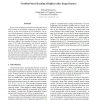115 search results - page 3 / 23 » Pairwise Features for Human Action Recognition |
119
click to vote
NIPS
2008
15 years 1 months ago
2008
We present a discriminative part-based approach for human action recognition from video sequences using motion features. Our model is based on the recently proposed hidden conditi...
ICPR
2006
IEEE
15 years 6 months ago
2006
IEEE
In this paper, we present a novel method for human action recognition from any arbitrary view image sequence that uses the Cartesian component of optical flow velocity and human ...
127
Voted
PAMI
2011
14 years 3 months ago
2011
—We present a discriminative part-based approach for human action recognition from video sequences using motion features. Our model is based on the recently proposed hidden condi...
125
click to vote
ICCV
2011
IEEE
14 years 9 days ago
2011
IEEE
Recent work on unsupervised feature learning has shown that learning on polynomial expansions of input patches, such as on pair-wise products of pixel intensities, can improve the...
115
click to vote
ICPR
2004
IEEE
16 years 1 months ago
2004
IEEE
Local space-time features capture local events in video and can be adapted to the size, the frequency and the velocity of moving patterns. In this paper we demonstrate how such fe...

